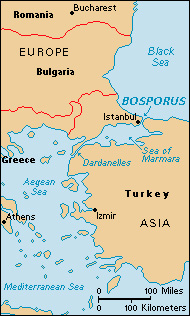Bosporus << BOS puhr uhs >> is a strait in northwestern Turkey that connects the Black Sea and the Sea of Marmara. It is part of a waterway that flows from the Black Sea to the Mediterranean Sea. The Bosporus (sometimes spelled Bosphorus) is 19 miles (31 kilometers) long. Istanbul lies along the strait.

The Bosporus has great commercial importance. The strait is an important outlet for ships of nations that border the Black Sea. Turkey owns the land on both sides of the Bosporus. At the Straits Convention in 1841, it was agreed that no war vessels could pass through the Bosporus and Dardanelles straits without the consent of Turkey (then called the Ottoman Empire). In 1923, the Treaty of Lausanne opened the straits to ships of all countries. In the Montreux Convention of 1936, Turkey regained control of the waterway.
The Bosporus gets its name from Greek words meaning ox ford, probably because it was so narrow in some places that cattle could cross. According to a Greek myth, the beautiful maiden Io swam the Bosporus in the form of a white cow. Darius I, a Persian king, built a famous bridge of boats across the Bosporus on his expedition into Thrace about 513 B.C.
A bridge across the Bosporus—the first since the bridge of boats built by Darius I—was completed in 1973. Called the Bosporus Bridge, it links the Asiatic and European sections of Istanbul. Today, two more bridges connect the two parts of Istanbul. They are the Fatih Sultan Mehmet Bridge (completed in 1988) and the Yavuz Sultan Selim Bridge (completed in 2016). In 2013, the city’s Marmaray tunnel began carrying rail traffic beneath the Bosporus.
See also Dardanelles; Istanbul; Marmara, Sea of.
